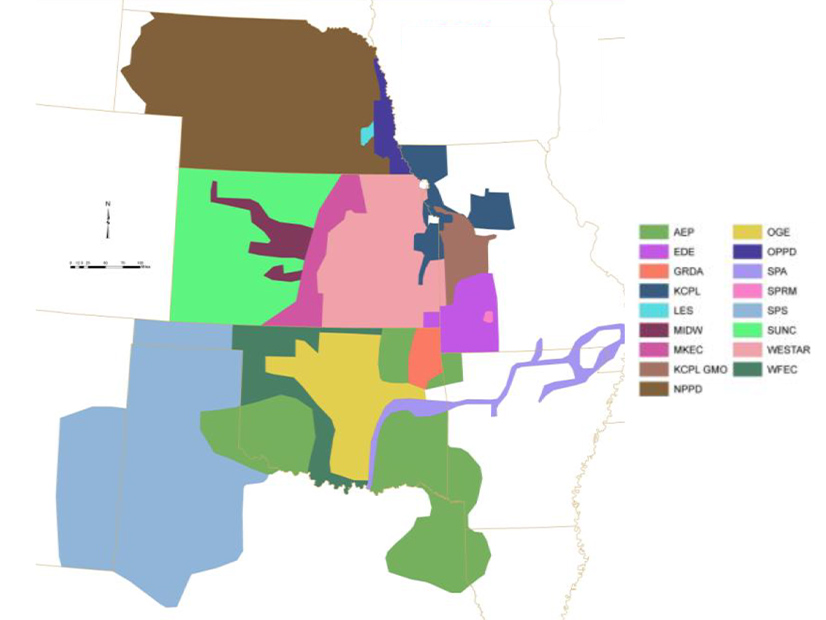FERC on Dec. 19 reiterated its rejection of SPP’s proposal to allocate “byway” transmission projects case by case, urging the RTO to vet the proposal through a stakeholder process (ER22-1846-004).
The commission’s order addressing arguments raised on rehearing defended its July 13 order, which rejected SPP’s proposed methodology. It said a rehearing request filed Aug. 14 by Sunflower Electric Power, Basin Electric Power Cooperative, Midwest Energy and Kansas Electric Power Cooperative had been denied “by operation of law” when the commission failed to act within 30 days.
FERC’s July order reversed a 3-2 ruling in October 2022 in which the commission had approved SPP’s proposal. (See SPP Planning Response After FERC Rejection of Tariff Revision.)
Since 2010, SPP has allocated transmission facilities based on the highway/byway method, with highway facilities (300 kV or above) assigned 100% on a regional, postage-stamp basis and byway facilities (between 100 and 300 kV) split, with 33% assigned regionally and 67% assigned to the pricing zone in which the facilities are located. Facilities at or below 100 kV are allocated 100% to the host zone.
Some stakeholders said that allocation method was unjust as applied in “generation-rich” pricing zones, where generation that is not affiliated with load in the zone significantly exceeds the amount of load in the zone — an issue of increasing importance because of the influx of wind generation on the SPP system.
In 2022, SPP proposed allowing parties to petition the RTO’s Board of Directors to reallocate byways as highways if they satisfy three criteria:
-
- Capacity: The total nameplate capacity of generating resources that are physically connected in the zone where the byway facility is located (and that are not affiliated with load in that zone) exceeds 100% of the prior calendar year’s average 12-coincident peak resident load.
- Flow: Energy flow on each byway facility that is attributed to generating resources physically connected in the zone where the byway is located and that are not affiliated with load in that zone exceeds 70% of the sum of flows on the byway facility attributed to generating resources affiliated with the load in the zone and generation physically connected in the zone and not affiliated with load there.
- Benefit: The byway facility provides benefits to load outside the pricing zone where the facility is located (e.g., adjusted production cost savings or savings through the Integrated Marketplace).
The commission initially approved the changes, saying it would help ensure the costs of byway facilities are allocated in a manner at least roughly commensurate with estimated benefits. It ordered the RTO to modify the language to specify that the board’s decision on such requests would be based solely on whether the three criteria were satisfied.
The decision was 3-2, with then-Chair Richard Glick and fellow Democrats Allison Clements and Willie Phillips in the majority, and Republicans James Danly and Mark Christie dissenting.
But after Glick’s term expired and Phillips was appointed chair, the commission reversed course in July in response to rehearing requests by utilities including Southwestern Electric Power Co., Oklahoma Gas & Electric and municipal utilities in Springfield and Kansas City, Mo. This time, Phillips and Clements joined Danly and Christie.
FERC ruled that even with the modifications it required, the tariff changes would grant the SPP board too much discretion because it could deny a requested reallocation even when RTO staff had determined the criteria were met, or approve a reallocation in which the criteria were not met.
The commission said it may reverse its prior position as long as it explains itself and that it does not need to establish that its newer position is superior to the previous one. The commission said allegations that SPP’s existing cost allocation method is unjust and unreasonable “are misplaced in a proceeding addressing a filing made under [Federal Power Act] Section 205. The proper vehicle for challenging existing tariff provisions as unjust and unreasonable is a complaint under FPA Section 206.”
In a joint concurrence with the order, Phillips and Clements said they were “sympathetic to … concerns that the commission’s decisions in this docket have caused parties to spend considerable resources over several years, without a solution to the deeper cost allocation challenges that prompted SPP’s filings in this proceeding.”
The commissioners said that while those seeking rehearing of the July ruling “raised compelling points that revisions to the highway/byway cost allocation approach may be appropriate under these circumstances, in our view the best path forward to address this issue would be an open, collaborative process between the relevant parties and stakeholders. Such open dialogue would allow for fulsome exploration of any legal or administrative barriers to potential cost allocation approaches, without some of the rigidity of a contested proceeding.”
The rehearing process, they said, “is not the ideal venue for the collaborative discussions that we envision would lead to durable policy solutions.”



